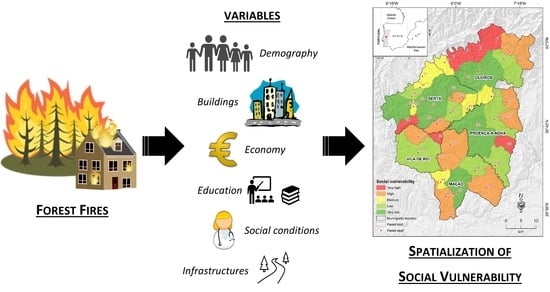Exploratory Spatial Analysis of Social Vulnerability and Forest Fire Risk in the Pinhal Interior Sul (Central Portugal)
Abstract
1. Introduction
2. Theoretical Background
3. Study Area
4. Materials and Methods
5. Results and Discussion
6. Conclusions
- (1)
- Creating and installing companies to manage forest combustibles, which would, in turn, create job opportunities, as well as creating professionalizing courses associated with this sector of economic activity;
- (2)
- Reinforcement of the municipal capacity to intervene in the management of the combustible containment strips on private pieces of land;
- (3)
- Promote a decrease in the unemployment rate and promote access to human resources;
- (4)
- Re-installation or replacement of infrastructure, as well as social and economic services that were being removed as the population declines;
- (5)
- Promote technical and academic studies on forest fire risk, which are of economic value to forests and help to create measures to reduce and mitigate the risk.
Author Contributions
Funding
Institutional Review Board Statement
Informed Consent Statement
Data Availability Statement
Acknowledgments
Conflicts of Interest
References
- Daveau, S.; Coelho, C.; Costa, V.G.; Carvalho, L. Répartition et Rythme des Précipitations au Portugal; Memórias do Centro de Estudos Geográficos; Centro de Estudos Geográficos: Lisbao, Portugal, 1977; pp. 1–192. [Google Scholar]
- Medeiros, C. Geografia de Portugal. o Ambiente Físico; Círculo de Leitores: Lisboa, Portugal, 2005; Volume 1. [Google Scholar]
- Hirschberger, P. FORESTS ABLAZE Causes and Effects of Global Forest Fires; WWF: Berlin, Germany, 2016. [Google Scholar]
- Oliveira, S.; Félix, F.; Nunes, A.; Lourenço, L.; Laneve, G.; Sebastián-López, A. Mapping wildfire vulnerability in Mediterranean Europe. Testing a stepwise approach for operational purposes. J. Environ. Manag. 2018, 206, 158–169. [Google Scholar] [CrossRef] [PubMed]
- San-Miguel-Ayánz, J.; Moreno, J.M.; Camia, A. Analysis of large fires in European Mediterranean landscapes: Lessons learned and perspectives. For. Ecol. Manag. 2013, 294, 11–22. [Google Scholar] [CrossRef]
- Tedim, F.; Remelgado, R.; Martins, J.; Carvalho, S. The largest forest fires in Portugal: The constraints of burned area size on the comprehension of fire severity. J. Environ. Biol. 2015, 36, 133–143. [Google Scholar]
- Nunes, A.; Lourenço, L.; Castro Meira, A.C. Exploring spatial patterns and drivers of forest fires in Portugal (1980–2014). Sci. Total Environ. 2016, 573, 1190–1202. [Google Scholar] [CrossRef] [PubMed]
- Turco, M.; Bedia, J.; Di Liberto, F.; Fiorucci, P.; von Hardenberg, J.; Koutsias, N.; Provenzale, A. Decreasing fires in Mediterranean Europe. PLoS ONE 2016, 11, e0150663. [Google Scholar] [CrossRef]
- Oliveira, S.; Zêzere, J.L.; Queiros, M.; Pereira, J.M. Assessing the social context of wildfire-affected areas. The case of mainland Portugal. Appl. Geogr. 2017, 88, 104–117. [Google Scholar] [CrossRef]
- Castro Meira, A.C.; Nunes, A.; Sousa, A.; Lourenço, L. Mapping the Causes of Forest Fires in Portugal by Clustering Analysis. Geosciences 2020, 10, 53. [Google Scholar] [CrossRef]
- Oliveira, S.; Gonçalves, A.; Zêzere, J.L. Reassessing wildfire susceptibility and hazard for mainland Portugal. Sci. Total Environ. 2021, 762, 143121. [Google Scholar] [CrossRef]
- Cunha, L. (Physical) Geography and Environmental Issues in Portugal. In Geographies of Mediterranean Europe; Lois-González, R.C., Ed.; Springer Geography: Berlin/Heidelberg, Germany, 2021; pp. 105–120. [Google Scholar]
- Busico, G.; Giuditta, E.; Kazakis, N.; Colombani, N. A Hybrid GIS and AHP Approach for Modelling Actual and Future Forest Fire Risk Under Climate Change Accounting Water Resources Attenuation Role. Sustainability 2019, 11, 7166. [Google Scholar] [CrossRef]
- EC. Forest Fires in Europe, Middle East and North Africa 2020; Publications Office: Luxembourg, 2021. Available online: https://publications.jrc.ec.europa.eu/repository/handle/JRC126766 (accessed on 23 February 2022).
- Dimuccio, L.; Ferreira, R.; Cunha, L.; Campar, A. Regional forest fire susceptibility analysis in central Portugal using a probabilistic ratings procedure and artificial neural network weights assignment. Int. J. Wildland Fire 2011, 20, 776–791. [Google Scholar] [CrossRef]
- Oliveira, S.; Bergonse, R.; Pinto Santos, P.; Gonçalves, A.; Melo, R.; Zêzere, J.L. Avaliação de Risco de Incêndios à escala local na região Centro de Portugal. In Geografia, Riscos e Proteção Civil. Homenagem ao Professor Doutor Luciano Lourenço; Nunes, A., Amaro, A., Vieira, A., Velez de Castro, F., Félix, F., Eds.; RISCOS—Associação Portuguesa de Riscos, Prevenção e Segurança: Coimbra, Portugal, 2021; Volume 2, pp. 79–89. [Google Scholar]
- Ghorbanzadeh, O.; Blaschke, T.; Gholamnia, K.; Aryal, J. Forest Fire Susceptibility and Risk Mapping Using Social/Infrastructural Vulnerability and Environmental Variables. Fire 2019, 2, 50. [Google Scholar] [CrossRef]
- ICNF. 10° Relatório Provisório de Incêndios Florestais—01 de Janeiro a 31 Outubro 2017 (Lisboa). Available online: http://www2.icnf.pt/portal/florestas/dfci/relat/rel-if/2017 (accessed on 15 October 2020).
- Fernandes, S.; Lourenço, L. Grandes incêndios florestais de Março, Junho e Outubro (fora do período crítico) em Portugal Continental. Territorium 2019, 26, 15–34. [Google Scholar] [CrossRef]
- Lourenço, L.; Félix, F. As vagas de incêndios florestais de 2017 em Portugal Continental, premissas de uma quarta ‘geração’? Territorium 2019, 26, 35–48. [Google Scholar]
- Turco, M.; Jerez, S.; Augusto, S.; Tarín-Carrasco, P.; Ratola, N.; Jiménez-Guerrero, P.; Trigo, R.M. Climate drivers of the 2017 devasting fires in Portugal. Sci. Rep. 2019, 9, 13886. [Google Scholar] [CrossRef]
- Viegas, X. Análise dos Incêndios Florestais Ocorridos a 15 de Outubro de 2017. Centro de Estudos sobre Incêndios Florestais, ADAI/LAETA; Departamento de Engenharia Mecânica, Faculdade de Ciências e Tecnologias, Universidade de Coimbra: Coimbra, Portugal, 2019. [Google Scholar]
- Almeida, A.C. Rural abandonment and landscape evolution in the central region of Portugal. In International Geographical Union: Issues in Geographical Marginality—Papers Presented during the Commission Meetings 2001–2004: Demographic Problems; Jones, G., Leimgruber, W., Nel, E., Eds.; Rhodes University: Makhanda, South Africa, 2007; pp. 53–63. [Google Scholar]
- Farinha, J. Território, Vulnerabilidade e Risco: Os Incêndios Florestais No Pinhal Interior Sul. Master’s Dissertation, Universidade de Coimbra, Coimbra, Portugal, 2020. [Google Scholar]
- Cutter, S.L.; Boruf, B.J.; Shirley, W.L. Social vulnerability to environmental hazards. Soc. Sci. Q. 2003, 84, 242–261. [Google Scholar] [CrossRef]
- Mendes, J.; Tavares, A.; Cunha, L.; Freiria, S. A vulnerabilidade social aos perigos naturais e tecnológicos em Portugal. Rev. Crít. Ciênc. Soc. 2011, 40, 95–128. [Google Scholar] [CrossRef]
- Cunha, L.; Mendes, J.; Tavares, A.; Freiria, S. Construção de modelos de avaliação de vulnerabilidade social a riscos naturais e tecnológicos. O desafio das escalas. In Trunfos de uma Geografia Ativa. Desenvolvimento Local, Ambiente, Ordenamento e Tecnologia; Santos, N., Cunha, L., Eds.; Imprensa da Universidade de Coimbra: Coimbra, Portugal, 2011; pp. 627–637. [Google Scholar]
- Cutter, S. A ciência da vulnerabilidade: Modelos, métodos e indicadores. Risco, vulnerabilidade social e cidadania. Rev. Crít. Ciênc. Soc. 2011, 93, 59–69. [Google Scholar] [CrossRef]
- Mendes, J. Sociologia do Risco–Uma Breve Introdução e Algumas Lições; Imprensa da Universidade de Coimbra: Coimbra, Portugal, 2015. [Google Scholar]
- Fischer, A.P.; Frazier, T.G. Social vulnerability to climate change in temperate forest areas: New measures of exposure, sensitivity, and adaptive capacity. Ann. Am. Assoc. Geogr. 2018, 108, 658–678. [Google Scholar] [CrossRef]
- Tavares, A. Riscos naturais e ordenamento do território—Modelos, práticas e políticas públicas a partir de uma reflexão para a Região Centro de Portugal. Prospect. Planeam. 2010, 17, 33–55. [Google Scholar]
- Jones, L. Os Grandes Desastres—Como os Desastres Naturais Nos Moldaram e o que Podemos Fazer para Os Prevenir; Vogais: Granja-Vialonga, Portugal, 2019. [Google Scholar]
- Julião, R.; Nery, F.; Ribeiro, J.; Branco, M.; Zêzere, J. Guia Metodológico para a Produção de Cartografia Municipal de Risco e para Criação de Sistemas de Informação Geográfica (SIG) de Base Municipal; Autoridade Nacional de Proteção Civil: Lisboa, Portugal, 2009.
- Beck, U. Sociedade de Risco. Rumo a uma Outra Modernidade; Editora 34: São Paulo, Brasil, 2010. [Google Scholar]
- Cunha, L. Vulnerabilidade: A face menos visível do estudo dos riscos naturais. In Homenagem ao Professor Fernando Rebelo; Lourenço, L., Mateus, M., Eds.; Departamento de Geografia, Faculdade de Letras da Universidade de Coimbra: Coimbra, Portugal, 2013; pp. 153–165. [Google Scholar]
- Cunha, L. Vulnerabilidade e riscos naturais: Exemplos em Portugal. In Vulnerabilidade e Riscos: Reflexões e Aplicações na Análise do Território; Freitas, M.I.C., Lombardo, M.A., Zacharias, A.A., Eds.; CEGOT e Departamento de Geografia, Universidade de Coimbra: Coimbra, Portugal, 2016; pp. 55–62. [Google Scholar]
- Bento-Gonçalves, A.; Vieira, A.; Nunes, A.; Lourenço, L.; Oliveira, S.; Félix, F. Análise de vulnerabilidade a incêndios florestais na região do Minho, Portugal. In III Congresso Internacional, I Simpósio Ibero-Americano, VII Encontro Nacional de Riscos, Guimarães; Associação Portuguesa de Riscos, Prevenção e Segurança: Coimbra, Portugal, 2014; pp. 721–725. [Google Scholar]
- de Diego, J.; Rúa, A.; Fernández, M. Vulnerability Variables and Their Effect on Wildfires in Galicia (Spain). A Panel Data Analysis. Land 2021, 10, 1004. [Google Scholar] [CrossRef]
- Thywissen, K. Components of Risk: A Comparative Glossary; UNU-EHS: Bonn, Germany, 2006. [Google Scholar]
- Guillard-Gonçalves, C.; Zêzere, J.L. Combining Social Vulnerability and Physical Vulnerability to Analyse Landslide Risk at the Municipal Scale. Geosciences 2018, 8, 294. [Google Scholar] [CrossRef]
- Guillard-Goncalves, C.; Cutter, S.L.; Emrich, C.T.; Zêzere, J.L. Application of Social Vulnerability Index (SoVI) and delineation of natural risk zones in Greater Lisbon, Portugal. J. Risk Res. 2015, 18, 651–674. [Google Scholar] [CrossRef]
- Coughlan, M.R.; Ellison, A.; Cavanaugh, A.H. Social Vulnerability and Wildfire in the Wildland-Urban Interface: Literature Synthesis. EWP Working Papers, Ecosystem Working Program, University of Oregon. 2019. Available online: https://scholarsbank.uoregon.edu/xmlui/handle/1794/25359 (accessed on 23 February 2022).
- Palaiologou, P.; Ager, A.A.; Nielsen-Pincus, M.; Evers, C.R.; Day, M.A. Social vulnerability to large wildfires in the western USA. Landsc. Urban Plan. 2019, 189, 99–116. [Google Scholar] [CrossRef]
- Verde, J.; Zêzere, J. Assessment and validation of wildfire susceptibility and hazard in Portugal. Nat. Hazards Earth Syst. Sci. 2010, 10, 485–497. [Google Scholar] [CrossRef]
- Porto, M. Complexidade, processos de vulnerabilização e justiça ambiental: Um ensaio de epistemologia política. Rev. Crít. Ciênc. Soc. 2011, 93, 31–58. [Google Scholar] [CrossRef]
- Cutter, S. The Changing Nature of Hazard and Disaster Risk in the Anthropocene. Ann. Am. Assoc. Geogr. 2021, 111, 819–827. [Google Scholar]
- Parente, J.; Pereira, M.G.; Amraoui, M.; Tedim, F. Negligent and intentional fires in Portugal: Spatial distribution characterization. Sci. Total Environ. 2018, 624, 424–437. [Google Scholar] [CrossRef]
- Cunha, L.; Gonçalves, A.B. Clima e tipos de tempo enquanto caraterísticas físicas condicionantes do risco de incêndios. Ensaio metodológico. Cad. Geogr. 1994, 13, 3–13. [Google Scholar]
- Pereira, M.G.; Trigo, R.M.; Camara, C.C.; Pereira, J.M.C.; Leite, S.M. Synoptic patterns associated with large summer forest fires in Portugal. Agric. For. Meteorol. 2005, 129, 11–25. [Google Scholar] [CrossRef]
- Pereira, M.G.; Calado, T.J.; DaCamara, C.C.; Calheiros, T. Effects of regional climate change on rural fires in Portugal. Clim. Res. 2013, 57, 187–200. [Google Scholar] [CrossRef]
- Ramos, A.; Almeida, A.; Lopes, F.; Cunha, L. Voyage d’Étude Littoral du Centre du Portugal: Serra da Boa Viagem—Nazaré, Livret Guide; Vème Colloque de I’AFGP, Géographie Physique et Société: Des Risques Naturales au Patrimonie Naturel: Coimbra, Portugal, 2019. [Google Scholar]
- Pereira, M.G.; Malamud, B.D.; Trigo, R.M.; Alves, P.I. The history and characteristics of the 1980–2005 Portuguese rural fire database. Nat. Hazards Earth Syst. Sci. 2011, 11, 3343. [Google Scholar] [CrossRef]
- Mira, M.; Lourenço, L. Grandes incêndios florestais de 17 de Junho de 2017 em Portugal e exemplos da determinação das respectivas causas. Territorium 2019, 26, 49–60. [Google Scholar] [CrossRef]
- Tedim, F.; Carvalho, S. Vulnerabilidade aos incêndios florestais: Reflexões em torno de aspectos conceptuais e metodológicos. Territorium 2013, 20, 85–99. [Google Scholar] [CrossRef]
- Souza, K.; Lourenço, L. A evolução do conceito de risco à luz das ciências naturais e sociais. Territorium 2015, 22, 31–44. [Google Scholar] [CrossRef][Green Version]
- Almeida, A.; Nunes, A.; Figueiredo, A. Dinâmica da população intraconcelhia no Interior Centro e Norte de Portugal. Cad. Geogr. 2008, 26–27, 41–52. [Google Scholar] [CrossRef]
- BGRI—Base Geográfica de Referenciação de Informação do Instituto Nacional de Estatística 2011. Available online: http://mapas.ine.pt/download/index2011.phtml (accessed on 15 October 2020).
- ICNF. 8° Relatório Provisório de Incêndios Florestais—01 de Janeiro a 15 Outubro 2019 (Lisboa). Available online: http://www2.icnf.pt/portal/florestas/dfci/relat/rel-if/2019 (accessed on 15 October 2020).
- Pereira, A.; Patrício, T. SPSS—Guia Prático de Utilização. Análise de dados para Ciências Sociais e Psicologia, 8th ed.; Edições Sílabo: Lisbao, Portugal, 2013. [Google Scholar]
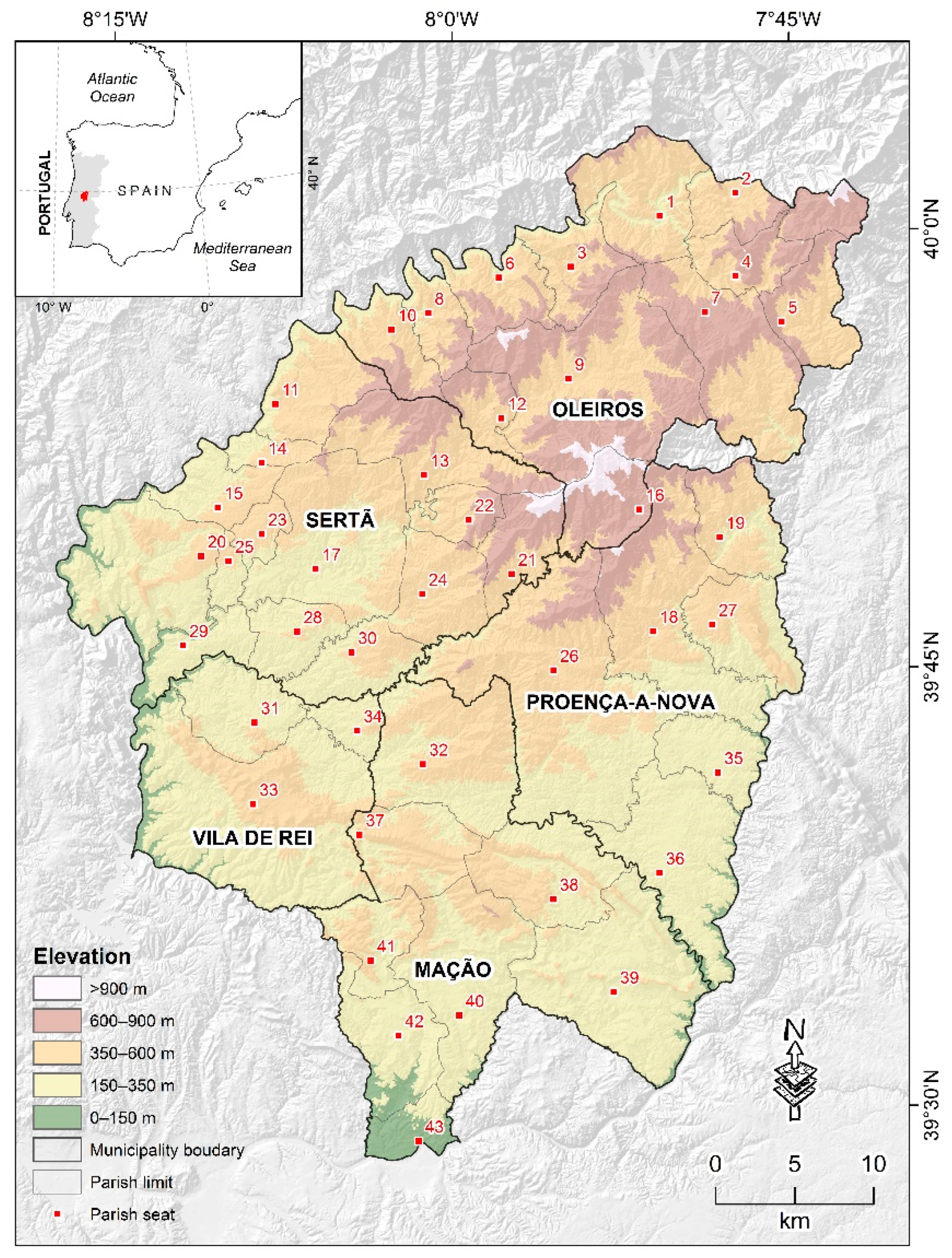
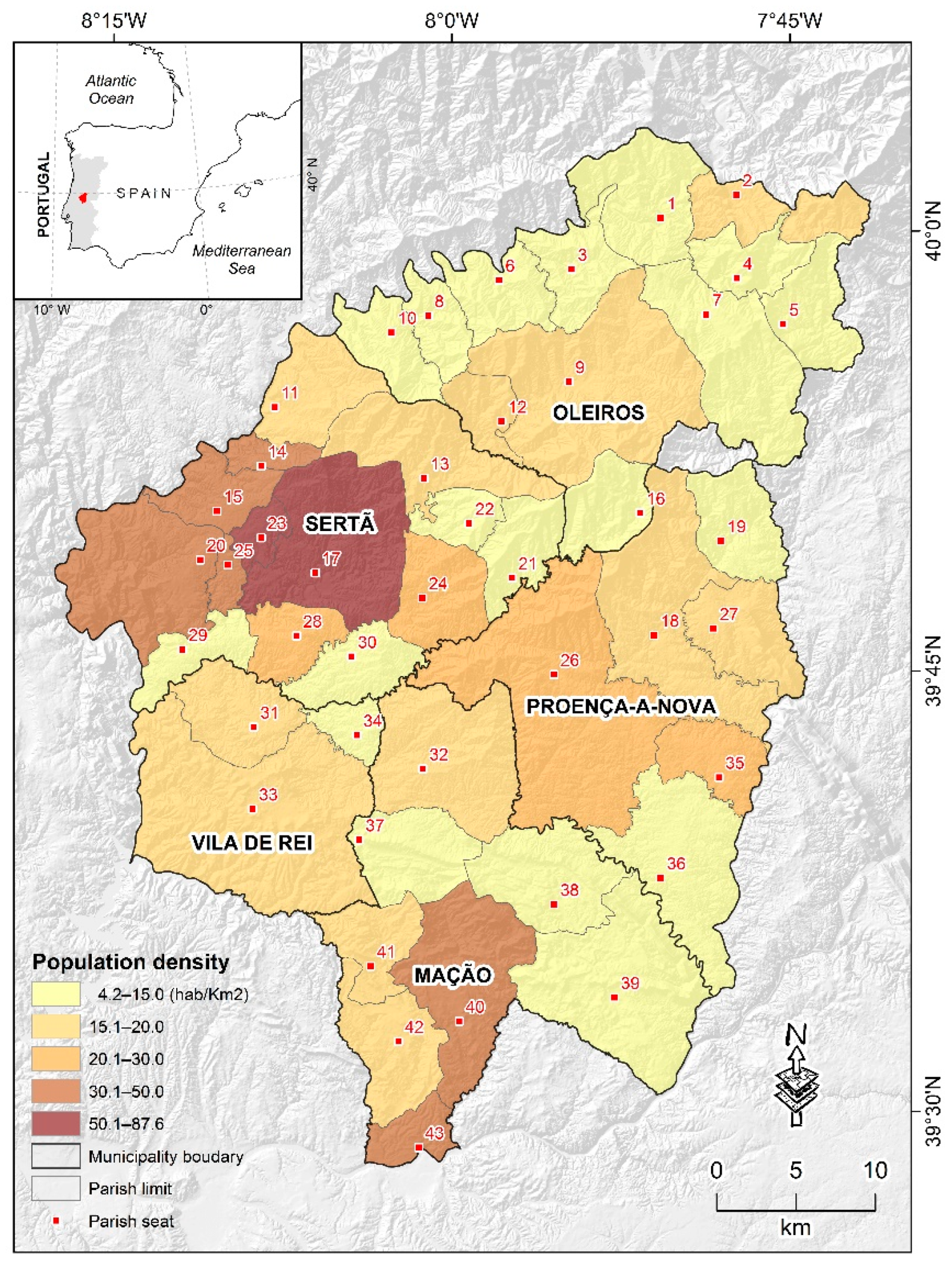
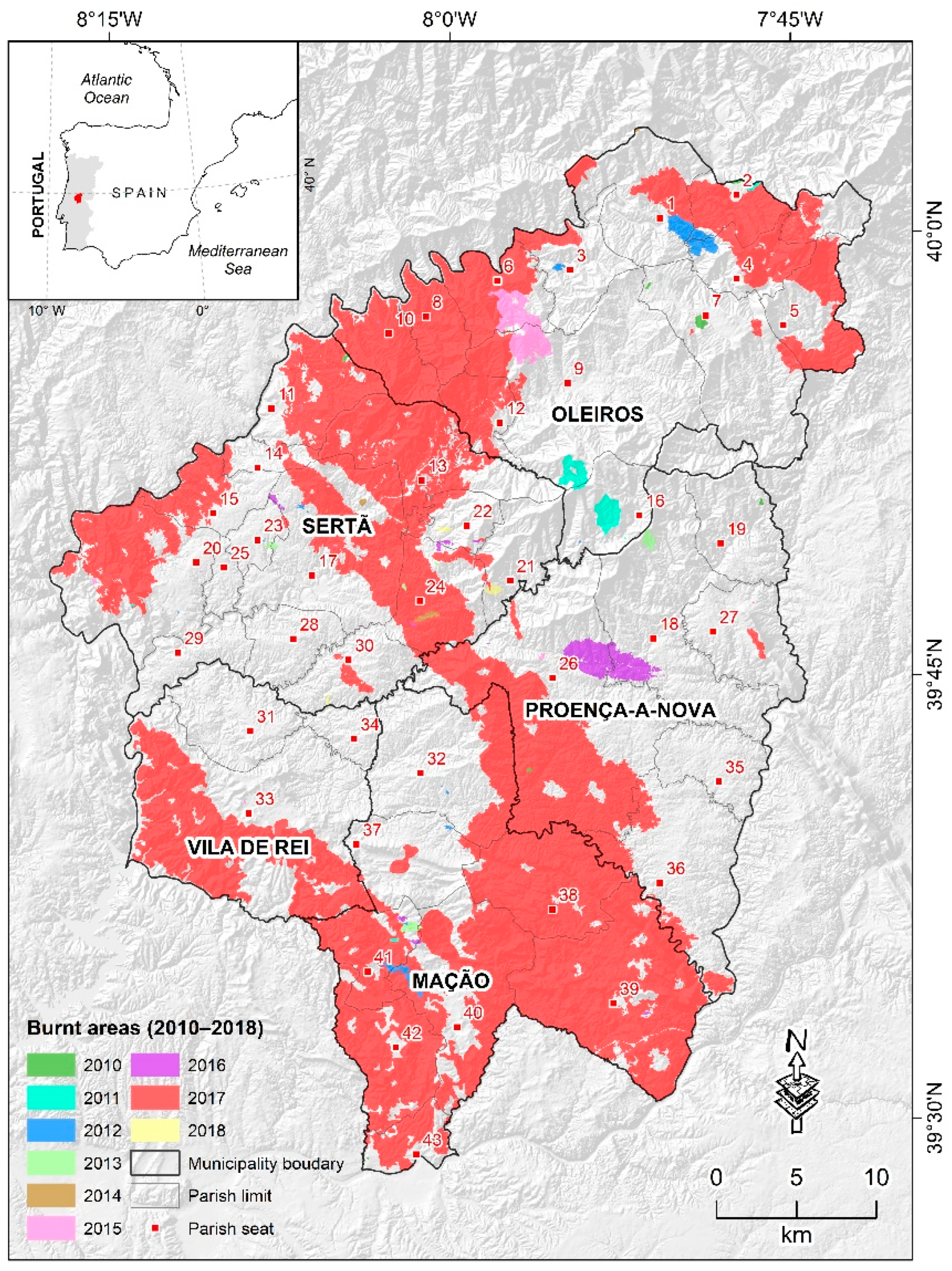
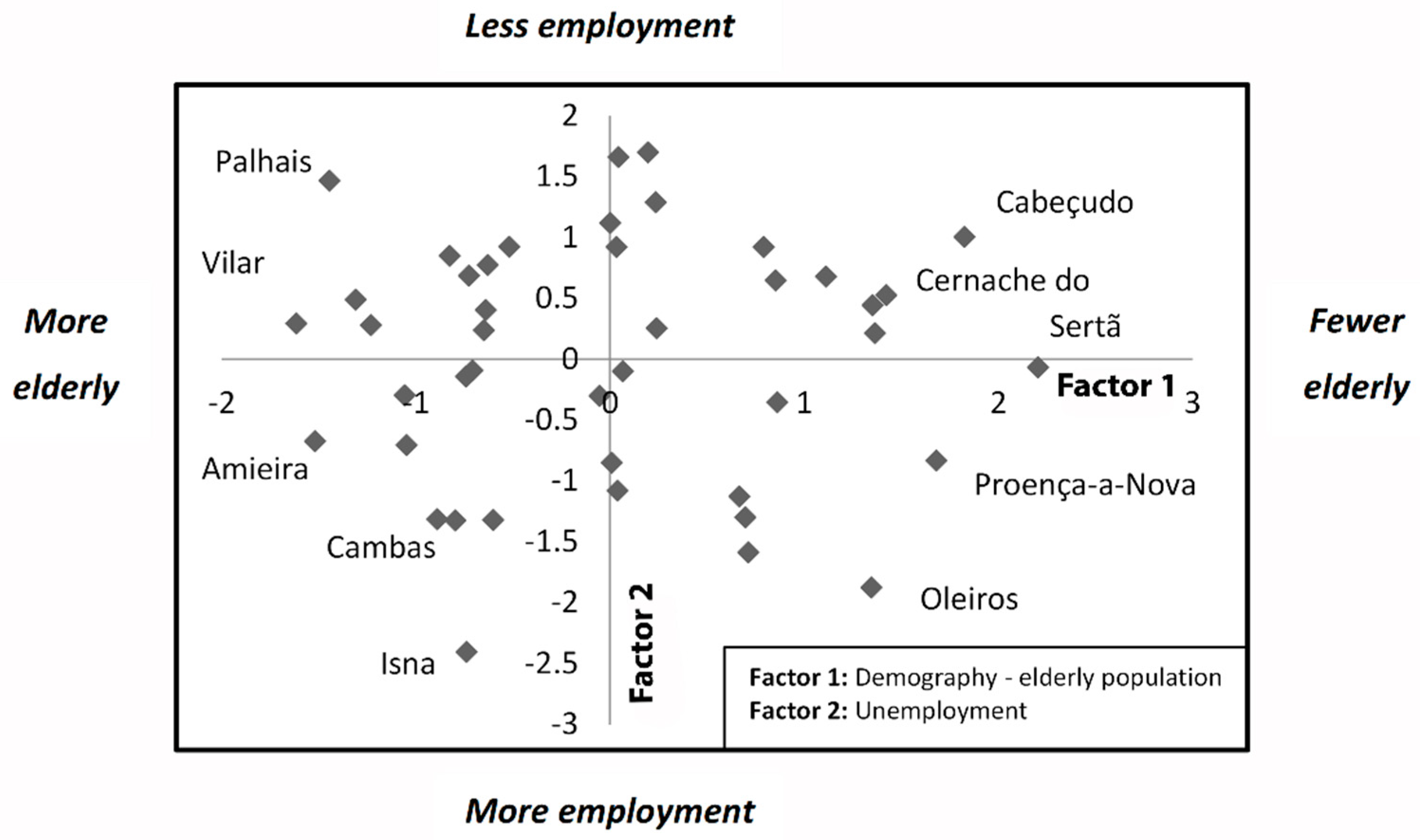
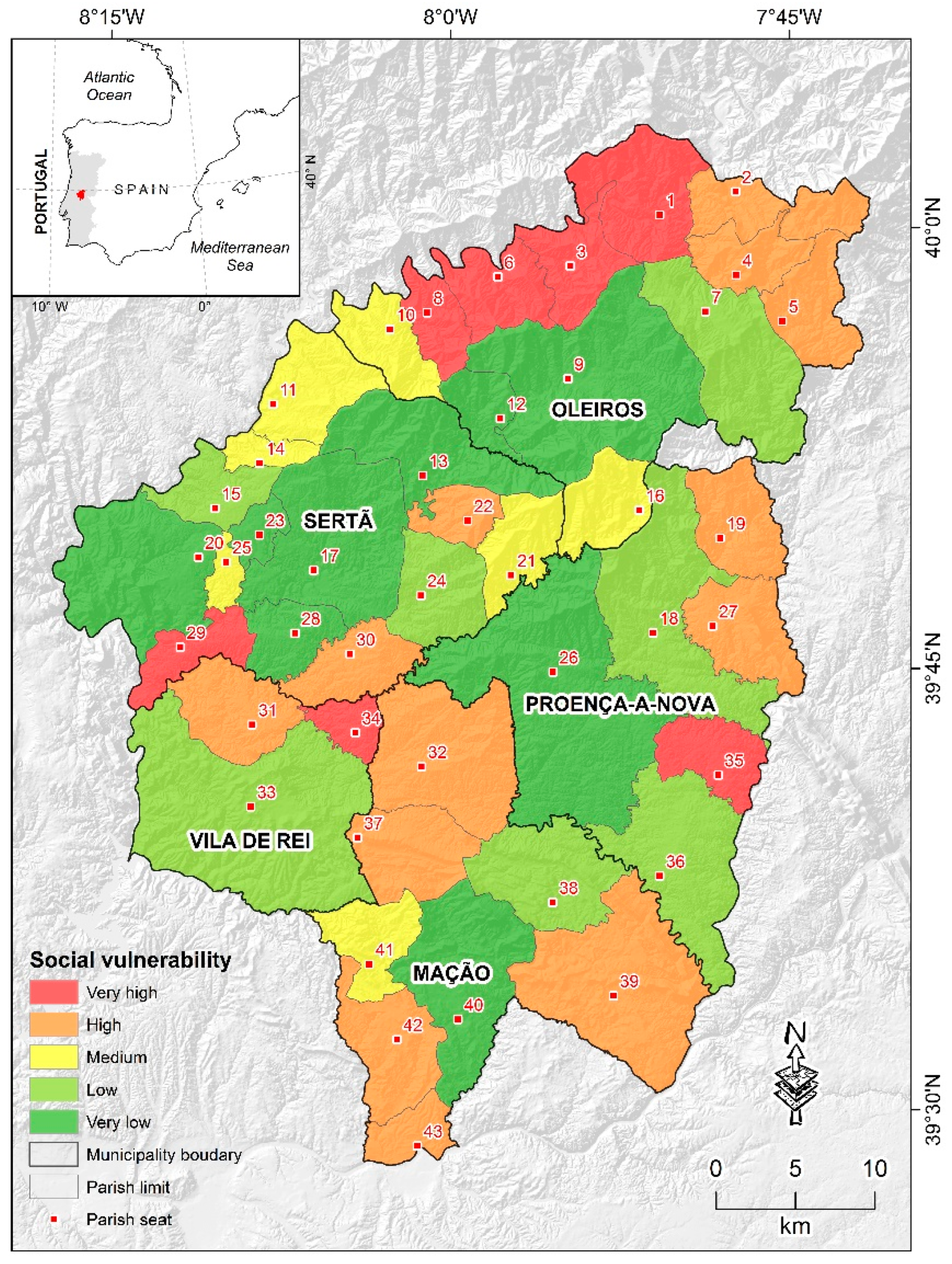
| Categories | Variables | ||
|---|---|---|---|
| Description | Model | Explanatory | |
| Demography | Population density | 8 | 2 |
| Rate of change in the present population (2001–2011) | |||
| Proportion of women | |||
| Proportion of the elderly population | |||
| Ageing index | |||
| Youth dependency index | |||
| Proportion of classic families with 1 or 2 people | |||
| Proportion of households with children under the age of 6 | |||
| Buildings | Building density | 11 | 7 |
| Proportion of classic buildings with 1 or 2 floors | |||
| Proportion of buildings with 1 or 2 floors | |||
| Proportion of old buildings (built before 1919 to 1945) | |||
| Proportion of new buildings (built from 2001 to 2011) | |||
| Proportion of families’ buildings | |||
| Proportion of classics in habitual dwellings | |||
| Proportion of buildings with adobe and stone structure | |||
| Proportion of vacant accommodations | |||
| Proportion of habitual dwellings with piped water | |||
| Proportion of usual residences with an area greater than 200 m2 (large houses) | |||
| Economy | Proportion of classic families with no unemployed members | 5 | 2 |
| Proportion of employed resident individuals | |||
| Proportion of resident individuals with retirement pensions | |||
| Proportion of resident individuals employed in the primary sector | |||
| Proportion of resident individuals working in the resident municipality | |||
| Education | Proportion of resident individuals studying in the resident municipality | 3 | 1 |
| Proportion of resident individuals who attend the 1st cycle of basic education | |||
| Proportion of individuals who cannot read and write | |||
| Social conditions | Number of pharmacies per 1000 inhabitants | 3 | 1 |
| Capacity of residential structure for elderly people per 1000 inhabitants | |||
| Number of kindergartens and preschool establishments per 1000 inhabitants | |||
| Infrastructures | Density of primary, secondary, and tertiary roads (km/km²) | 1 | 1 |
| Factor | Designation | Explained Variance (%) | Dominant Variable | Correlation (Dominant var./Factor) | Direction | Signal |
|---|---|---|---|---|---|---|
| 1 | Demography—elderly | 27.6 | Proportion of the elderly population | −0.9 | + | − |
| 2 | Unemployment | 8.3 | No. of classic families with no unemployed members | −0.6 | − | + |
| 3 | Demography—women | 8.1 | Proportion of women | 0.9 | + | + |
| 4 | Pharmacies | 6.7 | No. of pharmacies per 1000 inhabitants | 0.9 | − | − |
| 5 | Demography—Ageing | 6.6 | Ageing index | 0.9 | + | + |
| 6 | Age of the buildings | 6.2 | Proportion of old buildings (built between 1919 and 1945) | −0.8 | + | − |
| 7 | Families’ buildings | 5.3 | Proportion of families’ buildings | 0.7 | − | − |
| 8 | Buildings with water supply | 5.3 | Proportion of habitual buildings with piped water | 0.7 | − | − |
| 9 | Classic buildings | 5.1 | Proportion of classic buildings | 0.9 | − | − |
Publisher’s Note: MDPI stays neutral with regard to jurisdictional claims in published maps and institutional affiliations. |
© 2022 by the authors. Licensee MDPI, Basel, Switzerland. This article is an open access article distributed under the terms and conditions of the Creative Commons Attribution (CC BY) license (https://creativecommons.org/licenses/by/4.0/).
Share and Cite
Farinha, J.; Cunha, L.; Dimuccio, L.A. Exploratory Spatial Analysis of Social Vulnerability and Forest Fire Risk in the Pinhal Interior Sul (Central Portugal). Sustainability 2022, 14, 3010. https://doi.org/10.3390/su14053010
Farinha J, Cunha L, Dimuccio LA. Exploratory Spatial Analysis of Social Vulnerability and Forest Fire Risk in the Pinhal Interior Sul (Central Portugal). Sustainability. 2022; 14(5):3010. https://doi.org/10.3390/su14053010
Chicago/Turabian StyleFarinha, Joana, Lúcio Cunha, and Luca Antonio Dimuccio. 2022. "Exploratory Spatial Analysis of Social Vulnerability and Forest Fire Risk in the Pinhal Interior Sul (Central Portugal)" Sustainability 14, no. 5: 3010. https://doi.org/10.3390/su14053010
APA StyleFarinha, J., Cunha, L., & Dimuccio, L. A. (2022). Exploratory Spatial Analysis of Social Vulnerability and Forest Fire Risk in the Pinhal Interior Sul (Central Portugal). Sustainability, 14(5), 3010. https://doi.org/10.3390/su14053010







